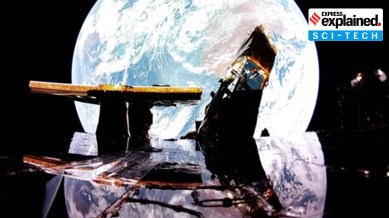Blue Ghost lands on Moon: Why more private players are flying to the lunar surface this year
Firefly is the third private operator to have sent a Moon mission under a special NASA programme called Commercial Lunar Payload Services. What is CLPS, and what does it aim to achieve?

An American private space company called Firefly Aerospace successfully landed its spacecraft on the Moon on Sunday, the first of the several arrivals that the lunar surface is expecting this year from different players. Firefly’s Blue Ghost mission is just the second time that a private space company has landed on the Moon, and the first such almost flawless landing.
Last year, Intuitive Machines, a ten-year-old company based in Houston, had landed its Odysseus spacecraft, marking a return of the United States on the lunar surface after five decades.
These private space missions have been facilitated by NASA, which is trying to build a larger ecosystem of space transportation companies in preparation for frequent travels to the Moon, for humans as well as cargo, in the coming years.
Probing the Moon
The first rounds of the private space missions are carrying a variety of scientific instruments, mostly those of NASA, to further our understanding of the Moon’s surface and its surroundings. Blue Ghost has taken instruments that will test robotic drilling technology, carry out studies of the surface and sub-surface characteristics and composition, and explore dust mitigation methods, among others. There are 10 payloads in all.
The spacecraft has landed about 20 degrees north of the Moon’s equator on the nearside, the side of the Moon that always faces the Earth. The site is known to have been impacted by a large asteroid about three billion years ago.
The payloads would be operational for one lunar day, or about 14 Earth days. The lander is equipped with some additional supplies of battery power, which will enable the functioning of the payloads for some time during the lunar night too. Lunar nights are very cold, making it difficult for most machines to survive.
On March 14, the mission is hoping to capture high-definition images of a solar eclipse on the Moon, with the Earth slated to come in between.
The Blue Ghost mission does not have a rover to walk over the Moon’s surface. The payloads will be deployed from the lander and remain static.
Commercial Lunar Payload Services
Firefly is the third private operator to have sent a Moon mission under a special NASA programme called Commercial Lunar Payload Services, or CLPS. More than a dozen space companies have been contracted by NASA so far to do sorties to the Moon with scientific instruments on a commercial basis and carry out experiments.
While NASA would be their main customers, sending a variety of payloads, the companies are free to take payloads of other interested parties, like universities, research institutions, private corporations or other countries.
CLPS is aimed at expediting the exploration of the Moon, and building capacities in the private sector to undertake complex space missions. This is part of NASA’s larger, and more ambitious, Artemis programme that aims to establish a long-term human presence on the Moon, exploit its natural resources, and use it as a base for further exploration of deep space.
The first flight to Moon under the CLPS initiative was launched in January last year, with Astrobotic Technologies sending its Peregrine mission. The mission developed technical problems during the flight and could not reach the Moon.
The Odysseus spacecraft by Intuitive Machines, launched just a month later, became the first private mission to reach the Moon, but its landing was not perfect. The spacecraft was unable to slow down adequately before landing, because of which at least one of its landing legs broke down on impact. The spacecraft managed to stay upright, though slightly tilted, and was able to relay data back to the control station.
Sunday’s landing of the Black Ghost mission was almost flawless, which prompted Firefly Aerospace to claim that it had become the first private company to “successfully” land on the Moon.
All these have been fairly straightforward lander-only missions, but future missions are planned to have rovers and return modules as well.
Heavy traffic
The entry of private operators ensures a greater frequency of trips to the Moon, and the deployment of a larger number of scientific instruments. Even as Blue Ghost landed on Sunday, the next CLPS mission is already on its way. Intuitive Missions launched its second mission, this one called Athena, or just IM-2, on February 26, and is supposed to land on March 6. Using a spacecraft similar to the first mission, IM-2 is scheduled to land in the relatively less-explored southern pole region of the Moon.
A Japanese private mission is also on its way to the Moon right now. The Hakuto-R Mission 2, by a company called ispace, was launched from the same SpaceX rocket as Blue Ghost in a unique double moonshot on January 15. It is taking a different, more energy-efficient route to the Moon and is scheduled to land in May or June. Japan’s first and only successful moon landing mission, called SLIM, had also taken a similar extended route last year. Hakuto-R has a lander called Resilience and a rover called Micro. Hakuto-R’s first mission in 2023 had been unsuccessful.
There could be a few more Moon landings this year, though their schedules are not firmed up. Astrobotic Technologies is planned to send its mission later this year, and Intuitive Machines might also launch its third mission, IM-3, by the year-end.